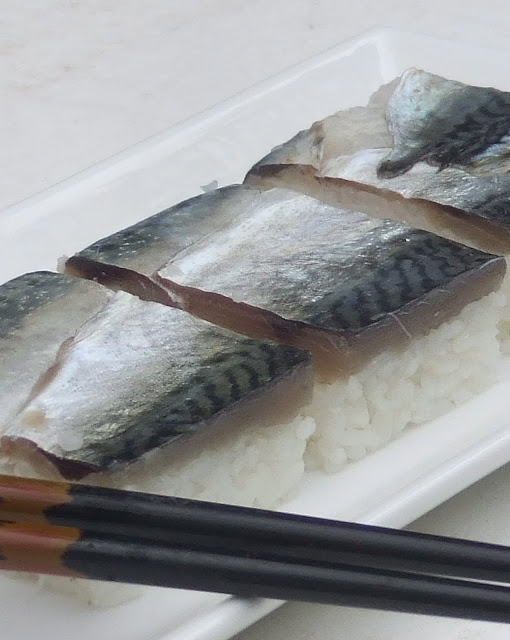Putting the Portuguese back in Sushi
 |
| My first attempt at Sushi - Algarvian carapau (mackerel) and Japanese sushi rice |
Sushi a Algarvia- The first in a series, which will follow my experiments with fusing the raw cooking of Portugal and Japan.I have been fascinated by sushi for many years, but never taken the step to cross the threshold from the customer in a Japanese restaurant situation to sushi chef. Reading about its history as an expat in Portugal gave me the necessary push.The lesson I learnt from my first venture into the land of Sushi was that I started with the most difficult sushi first and everything thereafter seemed a doddle.My advice to a novice sushi maker is set aside some time for your first attempt, this is not something you can rush into.Given the time, the ensuing reward is phenomenal.
The Portuguese lived in Japan, for generations before our own ancestors knew of its existence. They introduced words to the Japanese language, which are still current, including "orrigato" from"obrigado", meaning thank you.
Not quite Portuguese, but the Osaka style sushi´s boxed carapau (mackerel) is named after the Portuguese word “barca”, or small boat. The name evolved into the word battera, and is used commonly in Japan today. The word battera was derived by an Osaka sushi restaurant around 1893 to describe a sushi, which looked like a small boat, and eventually became a word just for boxed cured mackerel.
The battera uses fillets of a carapau (mackerel) and is placed inside a mould (sushi box, or hakozushigata) filled with sushi rice. A piece of vinegared kelp is placed on top, and pressed with the lid of the sushi box. They are cut in individual pieces and result in rectangular boxes.
Carapau ( mackerel) sushi pieces - battera
FOR THE RICE
If you are making bigger quantities or need the rice for other sushi items, quadruple the quantities below. The vinegar will help preserve it for a few days if kept wrapped, in a cool place.Sushi should never be put in the fridge it will go hard.
100ml sushi rice
3/4 tablespoon rice vinegar
1/2 tablespoon sugar
1/2 teaspoon sea salt
Put the rice in a large bowl and wash it thoroughly, changing the water several times, until clear.Drain and leave in the colander for 1 hour.If you don´t have the time, soak the rice in clear cold water for 15 minutes, then drain.
Transfer to a deep, heavy-based saucepan, add 115ml water. Cover and bring to the boil over a high heat, about 5 minutes.
Lower the heat and simmer, covered for about 10 minutes, or until all the water has been absorbed.Do not lift the lid. Remove from the heat and and leave to stand with the lid still on for a further 5 minutes.
Mix the rice vinegar, sugar and salt in a small bowl and stir until dissolved.
Transfer the cooked rice to a large, shallow dish and sprinkle abundantly with the vinegar dressing. Using a wooden spatula, fold the vinegar dressing into the rice. Do not stir. While folding, cool the rice quickly using a fan. Let the rice cool to body temperature, before assembling the sushi.
FOR THE SUSHI
1 medium sized fresh carapau (mackerel) about 400g, filleted
3-4 tablespoons rice vinegar
Sea salt crystals
vinegared sushi rice (see above)
HAND VINEGAR
2 tablespoons rice vinegar
125ml water
Start the preparation of this dish a few hours before cooking the rice. Take a dish larger than the fish fillets and cover with a thick layer of sea salt. Put the fish fillets flesh side down, on top of the salt and cover completely with more salt. Set aside for 4 hours. Remove the fish fillets and rub off the salt with damp paper towel. Carefully remove all the bones with tweezers, then put into a dish and pour the rice vinegar over the fish. Leave to marinate for a further 30 minutes.
Make the vinegared rice if you haven´t already done so, following the recipe above.
Mix the hand vinegar ingredients in a small bowl and set aside.
Put the fillets skin side down, on a cutting board and slice off the highest part from the centre of the flesh so the fillets will be fairly flat. Keep the trimmings.
Line a wet rectangular container with a large piece of clinfilm. I used a straight edged Loose Bottom Rectangular Quiche/Tart Pan 35 x 13cm.
Carapau ( mackerel) sushi pieces - battera
FOR THE RICE
If you are making bigger quantities or need the rice for other sushi items, quadruple the quantities below. The vinegar will help preserve it for a few days if kept wrapped, in a cool place.Sushi should never be put in the fridge it will go hard.
100ml sushi rice
3/4 tablespoon rice vinegar
1/2 tablespoon sugar
1/2 teaspoon sea salt
Put the rice in a large bowl and wash it thoroughly, changing the water several times, until clear.Drain and leave in the colander for 1 hour.If you don´t have the time, soak the rice in clear cold water for 15 minutes, then drain.
Transfer to a deep, heavy-based saucepan, add 115ml water. Cover and bring to the boil over a high heat, about 5 minutes.
Lower the heat and simmer, covered for about 10 minutes, or until all the water has been absorbed.Do not lift the lid. Remove from the heat and and leave to stand with the lid still on for a further 5 minutes.
Mix the rice vinegar, sugar and salt in a small bowl and stir until dissolved.
Transfer the cooked rice to a large, shallow dish and sprinkle abundantly with the vinegar dressing. Using a wooden spatula, fold the vinegar dressing into the rice. Do not stir. While folding, cool the rice quickly using a fan. Let the rice cool to body temperature, before assembling the sushi.
FOR THE SUSHI
1 medium sized fresh carapau (mackerel) about 400g, filleted
3-4 tablespoons rice vinegar
Sea salt crystals
vinegared sushi rice (see above)
HAND VINEGAR
2 tablespoons rice vinegar
125ml water
Start the preparation of this dish a few hours before cooking the rice. Take a dish larger than the fish fillets and cover with a thick layer of sea salt. Put the fish fillets flesh side down, on top of the salt and cover completely with more salt. Set aside for 4 hours. Remove the fish fillets and rub off the salt with damp paper towel. Carefully remove all the bones with tweezers, then put into a dish and pour the rice vinegar over the fish. Leave to marinate for a further 30 minutes.
Make the vinegared rice if you haven´t already done so, following the recipe above.
Mix the hand vinegar ingredients in a small bowl and set aside.
Put the fillets skin side down, on a cutting board and slice off the highest part from the centre of the flesh so the fillets will be fairly flat. Keep the trimmings.
Line a wet rectangular container with a large piece of clinfilm. I used a straight edged Loose Bottom Rectangular Quiche/Tart Pan 35 x 13cm.
Put a fillet, skin side down,in the container, Fill the gaps with the other fillet and trimmings. Dip your fingers in the hand vinegar, then press the cooked rice down firmly on top of the fish.Fold the clingfilm in and put a piece of thick cardboard cut to the size of your container on top with a weight.
You can leave it in a cool place( not the refrigerator for a few hours.When ready to serve,remove from the container and unwrap the clingfilm. Take a very sharp knife and wipe it with a vinegar soaked cloth or piece of kitchen paper.Cut the block of sushi in 4 lengthways, then in 4 crossways, making 16 pieces in all.The division of the block and number of pieces may vary according to the size and shape of container you use.Arrange on a tray or plate and serve with individual bowls of soya sauce and wasabi.
Arigato gozaimasu for reading.
Arigato gozaimasu for reading.


Comments
Post a Comment